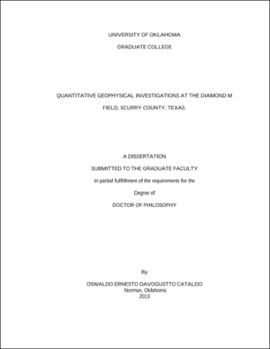| dc.contributor.advisor | Marfurt, Kurt J | |
| dc.creator | Davogustto, Oswaldo | |
| dc.date.accessioned | 2019-04-27T21:33:49Z | |
| dc.date.available | 2019-04-27T21:33:49Z | |
| dc.date.issued | 2013 | |
| dc.identifier | 99301074602042 | |
| dc.identifier.uri | https://hdl.handle.net/11244/319027 | |
| dc.description.abstract | The Diamond M field over the Horseshoe Atoll reservoir of west Texas has produced oil since 1942. Even with some 210 well penetrations, complex reservoir compartmentalization has justified an ongoing drilling program with three wells drilled within the last three years. Accurate reservoir characterization requires accurate description of the geometry, geological facies, and petrophysical property distribution ranging from core, through log to the seismic scale. | |
| dc.description.abstract | The operator has conducted a careful logging and coring process including dipole sonic logs in addition to acquiring a modern 3D vertical phone - vertical vibrator "P-wave" seismic data volume and an equivalent size 2-component by 2-componet "S-wave" seismic data volume. I analyze these data at different scales, integrating them into a whole. I begin with core analysis of the petrophysical properties of the Horseshoe Atoll reservoir. Measuring porosity, permeability, NMR T2 relaxation and velocities (Vp and Vs) as a function of pressure and find that porosity measurements are consistent when measured with different techniques. When upscaled, these measurements are in excellent agreement with properties measured at the log scale. Together, these measurements provide a lithology-porosity template against which I correlate my seismic P- and S-impedance measurements. | |
| dc.description.abstract | Careful examination of P- and S-impedances as well as density from prestack inversion of the P-wave survey of the original time migrated gathers showed lower vertical resolution for S-impedance and density. These latter two parameters are controlled by the far-offset data, which suffers from migration stretch. I address this shortcoming by applying a recently developed non-stretch NMO technique which not only improved the bandwidth of the data but also resulted in inversions that better match the S-impedance and density well log data. | |
| dc.description.abstract | The operator hypothesized that 2C by 2C S-wave data would better delineate lithology than conventional P-wave seismic data. Although introduced in the mid-1980s, 2C by 2C data are rarely acquired, with most surveys showing less vertical resolution than conventional (and prior to slip-sweep technology more economically acquired) P-wave data. Initial processing by the service company showed a comparable, but lower frequency, image for the "transverse" component, and poor images for the "radial" component. Although the dipole sonic logs did not indicate the presence of significant anisotropy, shear wave splitting is readily observed on the surface seismic stacks. I therefore developed a prestack Alford rotation algorithm that minimizes the cross-talk between components, resulting vertical resolution comparable to the P-wave data, and independent measure of lithology, and also a direct measure of the direction of the principal axes of anisotropy. | |
| dc.description.abstract | The direction of azimuthal anisotropy is aligned N45E consistent with the regional maximum horizontal stress axis obtained from the world stress map database. On average, the Cisco Formation appears 10% thicker on the slow shear (S2) volume than on the fast shear (S1) volume and between 70% and 100% thicker on the P-wave volume. Cross-plotting cumulative production against the various seismic attributes, I find a strong negative correlation to S-impedance and P-impedance. Zones of low S-impedance and low P-impedance correlate to better producing wells. More quantitative correlation will require the analysis of the role fractures versus porosity contribute to production. | |
| dc.format.extent | 285 pages | |
| dc.format.medium | application.pdf | |
| dc.language | en_US | |
| dc.relation.requires | Adobe Acrobat Reader | |
| dc.subject | Geophysics--Texas--Scurry County | |
| dc.subject | Petroleum--Geology | |
| dc.subject | Oil well logging | |
| dc.subject | Seismic tomography--Texas--Scurry County | |
| dc.subject | Seismic reflection method | |
| dc.title | Quantitative Geophysical Investigations at the Diamond M field, Scurry County, Texas | |
| dc.type | text | |
| dc.type | document | |
| dc.thesis.degree | Ph.D. | |
| ou.group | Mewbourne College of Earth and Energy::ConocoPhillips School of Geology and Geophysics | |
